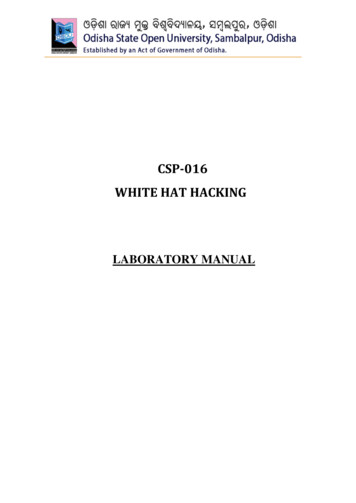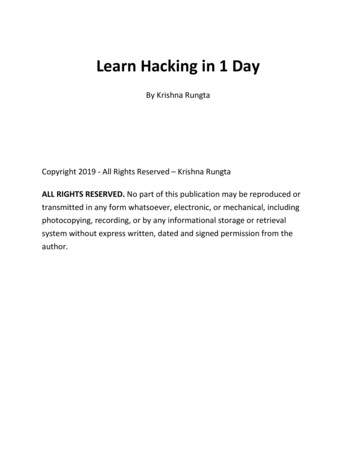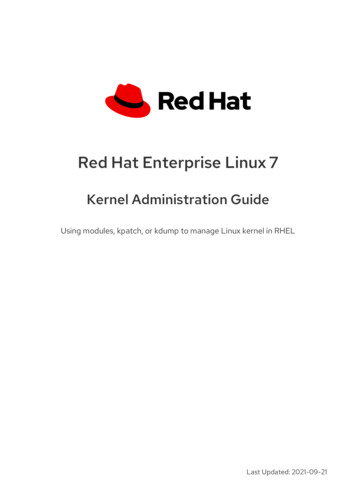
Transcription
CSP-016WHITE HAT HACKINGLABORATORY MANUAL
Dr. P.K BeheraReader in Computer ScienceUtkal UniversityBhubaneswar, Odisha(Chairman)Dr.J.RMohantyProfessor and HODKIIT UniversityBhubaneswar, Odisha(Member)Sri PabitranandaPattnaikScientist-E, NICBhubaneswar, Odisha(Member)Sri Malaya Kumar DasScientist-E, NICBhubaneswar, Odisha(Member)Dr. Bhagirathi NayakProfessor and Head (IT & System)Sri Sri University, Bhubaneswar,Odisha(Member)Dr.Manoranjan PradhanProfessor and Head (IT & System)G.I.T.ABhubaneswar, Odisha(Member)Sri ChandrakantMallickConsultant (Academic)School of Computer and Information ScienceOdisha State Open UniversitySambalpur,Odisha(Convener)Course WriterEditorGyana Ranjan PanigrahiB.J.B Autonomus College,BhubaneswarChandrakant MallickCollege of Engineering,BhubaneswarMaterial ProductionDr. Jayanta Kar SharmaRegistrarOdisha State Open University, Sambalpur OSOU, 2017. White Hat Hacking , Laboratory Manual is madeavailable under a Creative Commons g/licences/by-sa/4.0 Printed by :Shri Mandir Publication, Sahid Nagar, BhubaneswarOdisha State Open University2
WHITE HAT HACKINGLABORATORYLIST OF EXPERIMENTSerialNo.Experiment1To learn about hacking tools and skills.2To study about Footprinting and Reconnaissance.3To study about Fingerprinting.4To study about system Hacking.5To study about Wireless Hacking.6To learn & study about Sniffing & their tools.Odisha State Open University3
EXPERIMENT-1Aim: To learn about hacking tools and skills.Learning Objective :At the end of the session you will be able to familiarize withpopular hacking tools.understand various hacking techniques in brief.learn some of the skills that you would require to become an expert in EthicalHacking.Structure :1.1 Introduction1.1.1 NMAP1.1.2 Metasploit1.1.3 Burp Suite1.1.4 Angry IP Scanner1.1.5 Cain & Abel1.1.6 Ettercap1.1.7 EtherPeek1.1.8 SuperScan1.1. 1.9 QualysGuard1.1.10 WebInspect1.1.11 LC41.1.12 LANguard Network Security Scanner1.1.13 Network Stumbler1.1.14 One Loc1.2 Hacking Skills1.3 Basic Skills1.4 Courses & Certifications1.5 Final NoteOdisha State Open University4
1.1 IntroductionIn this manual, we will discuss in brief some of famous tools that are widely used toprevent hacking and getting unauthorized access to a computer or network system.1.1.1 NMAPNmap stands for Network Mapper. It is an open source tool that is used widely fornetwork discovery and security auditing. Nmap was originally designed to scan largenetworks, but it can work equally well for single hosts. Network administrators also findit useful for tasks such as network inventory, managing service upgrade schedules, andmonitoring host or service uptime.Nmap uses raw IP packets to determine: what hosts are available on the network, what services those hosts are offering, what operating systems they are running on, what type of firewalls are in use, and other such characteristics.Nmap runs on all major computer operating systems such as Windows, Mac OS X, andLinux.1.1.2 MetasploitMetasploit is one of the most powerful exploit tools. It’s a product of Rapid7 and most ofits resources can be found at: www.metasploit.com. It comes in two versions commercial and free edition. Metasploit can be used with command prompt or with WebUI.With Metasploit, you can perform the following operations: Conduct basic penetration tests on small networks. Run spot checks on the exploitability of vulnerabilities. Discover the network or import scan data. Browse exploit modules and run individual exploits on hosts.1.1.3 Burp SuiteBurp Suite is a popular platform that is widely used for performing security testing ofweb applications. It has various tools that work in collaboration to support the entiretesting process, from initial mapping and analysis of an application's attack surface,through to finding and exploiting security vulnerabilities.Burp is easy to use and provides the administrators full control to combine advancedmanual techniques with automation for efficient testing. Burp can be easily configuredand it contains features to assist even the most experienced testers with their work.Odisha State Open University5
1.1.4 Angry IP ScannerAngry IP scanner is a lightweight, cross-platform IP address and port scanner. It can scanIP addresses in any range. It can be freely copied and used anywhere. In order to increasethe scanning speed, it uses multithreaded approach, wherein a separate scanning thread iscreated for each scanned IP address.Angry IP Scanner simply pings each IP address to check if it’s alive, and then, it resolvesits hostname, determines the MAC address, scans ports, etc. The amount of gathered dataabout each host can be saved to TXT, XML, CSV, or IP-Port list files. With help ofplugins, Angry IP Scanner can gather any information about scanned IPs.1.1.5 Cain & AbelCain & Abel is a password recovery tool for Microsoft Operating Systems. It helps ineasy recovery of various kinds of passwords by employing any of the following methods: sniffing the network, cracking encrypted passwords using Dictionary, Brute-Force and Cryptanalysisattacks, recording VoIP conversations, decoding scrambled passwords, recovering wireless network keys, revealing password boxes, uncovering cached passwords and analyzing routing protocols.Cain & Abel is a useful tool for security consultants, professional penetration testers andeveryone else who plans to use it for ethical reasons.1.1.6 EttercapEttercap stands for Ethernet Capture. It is a network security tool for Man-in-the-Middleattacks. It features sniffing of live connections, content filtering on the fly and many otherinteresting tricks. Ettercap has inbuilt features for network and host analysis. It supportsactive and passive dissection of many protocols.You can run Ettercap on all the popular operating systems such as Windows, Linux, andMac OS X.1.1.7 EtherPeekEtherPeek is a wonderful tool that simplifies network analysis in a multiprotocolheterogeneous network environment. EtherPeek is a small tool (less than 2 MB) that canbe easily installed in a matter of few minutes.EtherPeek proactively sniffs traffic packets on a network. By default, EtherPeek supportsprotocols such as AppleTalk, IP, IP Address Resolution Protocol (ARP), NetWare, TCP,UDP, NetBEUI, and NBT packets.Odisha State Open University6
1.1.8 SuperScanSuperScan is a powerful tool for network administrators to scan TCP ports and resolvehostnames. It has a user-friendly interface that you can use to: Perform ping scans and port scans using any IP range. Scan any port range from a built-in list or any given range. View responses from connected hosts. Modify the port list and port descriptions using the built-in editor. Merge port lists to build new ones. Connect to any discovered open port. Assign a custom helper application to any port.1.1.9 QualysGuardQualysGuard is an integrated suite of tools that can be utilized to simplify securityoperations and lower the cost of compliance. It delivers critical security intelligence ondemand and automates the full spectrum of auditing, compliance and protection for ITsystems and web applications.QualysGuard includes a set of tools that can monitor, detect, and protect your globalnetwork.1.1.10 WebInspectWebInspect is a web application security assessment tool that helps identify known andunknown vulnerabilities within the Web application layer.It can also help check that a Web server is configured properly, and attempts commonweb attacks such as parameter injection, cross-site scripting, directory traversal, andmore.1.1.11 LC4LC4 was formerly known as L0phtCrack. It is a password auditing and recoveryapplication. It is used to test password strength and sometimes to recover lost MicrosoftWindows passwords, by using dictionary, brute-force, and hybrid attacks.LC4 recovers Windows user account passwords to streamline migration of users toanother authentication system or to access accounts whose passwords are lost.1.1.12 LANguard Network Security ScannerLANguard Network Scanner monitors a network by scanning connected machines andproviding information about each node. You can obtain information about eachindividual operating system.It can also detect registry issues and have a report set up in HTML format. For eachcomputer, you can list the netbios name table, current logged-on user, and Mac address.Odisha State Open University7
1.1.13 Network StumblerNetwork stumbler is a WiFi scanner and monitoring tool for Windows. It allows networkprofessionals to detect WLANs. It is widely used by networking enthusiasts and hackersbecause it helps you find non-broadcasting wireless networks.Network Stumbler can be used to verify if a network is well configured, its signalstrength or coverage, and detect interference between one or more wireless networks. Itcan also be used to non-authorized connections.1.1.14 ToneLocToneLoc stands for Tone Locator. It was a popular war dialing computer program writtenfor MS-DOS in the early 90’s. War dialing is a technique of using a modem toautomatically scan a list of telephone numbers, usually dialing every number in a localarea code.Malicious hackers use the resulting lists in breaching computer security - for guessinguser accounts, or locating modems that might provide an entry-point into computer orother electronic systems.It can be used by security personnel to detect unauthorized devices on a company’stelephone network.1.2 Hacking SkillsAs an ethical hacker, you will need to understand various hacking techniques such as: Password guessing and cracking Session hijacking Session spoofing Network traffic sniffing Network traffic sniffing Denial of Service attacks Exploiting buffer overflow vulnerabilities SQL injection1.3 Basic SkillsComputer Hacking is a Science as well as an Art. Like any other expertise, you need toput a lot of effort in order to acquire knowledge and become an expert hacker. Once youare on the track, you would need more effort to keep up-to-date with latest technologies,new vulnerabilities and exploitation techniques. An ethical hacker must be a computer systems expert and needs to have very strongprogramming and computer networking skills.Odisha State Open University8
An ethical hacker needs to have a lot of patience, persistence, and perseverance to tryagain and again and wait for the required result.Additionally, an ethical hacker should be smart enough to understand the situation andother users’ mind-set in order to apply social engineering exploits. A good ethical hackerhas great problem-solving skills too.1.4 Courses & CertificationsThis provides the basic guidelines to become a successful Ethical Hacker. If you want toexcel in this field, then you might choose to pursue the following courses andcertifications: Obtain a bachelor’s degree in Computer Science or A Certificate to gain anunderstanding of the most common hardware and software technologies. Get into a programmer’s role for a few years and then switch to get a tech supportposition. Proceed to get network certifications like Network or CCNA and then securitycertifications like Security , CISSP, or TICSA. It is recommended that you get some work experience as a Network Engineer andSystem Administrator to understand networks and systems inside out. Keep going through various books, tutorials and papers to understand variouscomputer security aspects and take them as a challenge to secure your networkand computer systems as network security engineer. Study courses which cover creating Trojan horses, backdoors, viruses, andworms, denial of service (DoS) attacks, SQL injection, buffer overflow, sessionhijacking, and system hacking. Master the art of penetration testing, Footprinting and Reconnaissance, and Socialengineering. Finally go for a Certified Ethical Hacker (CEH) Certification.GIAC (Global Information Assurance Certification) and Offensive Security CertifiedProfessional (OSCP) are additional IT security certifications which will add a lot of valueto your profile.1.5 Final NoteYou need to stay as a White Hat Hacker which means you need to work within givenboundaries. Never intrude or attack any computer or network without a requiredpermission from the authorities.As a final note, it is highly recommended that you refrain from engaging yourself inblack hat hacking which may spoil your entire career.Odisha State Open University9
EXPERIMENT-2Aim: To study about “Footprinting and Reconnaissance”.Learning ObjectiveAt the end of the session you will be able to gather possible information about a target computer system or network.how to extract the basic and easily accessible information about any computersystem or network that is linked to the Internet.Structure :2.1 Introduction2.2 Domain Name Information2.3 Quick Fix2.4 Finding IP Address2.5 Finding Hosting Company2.6 Quick Fix2.7 IP Address Ranges2.8 History of the Website2.9 Quick Fix2.1 IntroductionFootprinting is a part of reconnaissance process which is used for gathering possibleinformation about a target computer system or network. Footprinting could be bothpassive and active. Reviewing a company’s website is an example of passiveFootprinting, whereas attempting to gain access to sensitive information through socialengineering is an example of active information gathering.Footprinting is basically the first step where hacker gathers as much information aspossible to find ways to intrude into a target system or at least decide what type of attackswill be more suitable for the target.During this phase, a hacker can collect the following information: Domain nameIP AddressesOdisha State Open University10
NamespacesEmployee informationPhone numbersE-mailsJob InformationIn the following section, we will discuss how to extract the basic and easily accessibleinformation about any computer system or network that is linked to the Internet.2.2 Domain Name InformationYou can use http://www.whois.com/whois website to get detailed information about adomain name information including its owner, its registrar, date of registration, expiry,name server, owner's contact information, etc.Here is a sample record of www.tutorialspoint.com extracted from WHOIS Lookup:Odisha State Open University11
2.3 Quick FixIt's always recommended to keep your domain name profile a private one which shouldhide the above-mentioned information from potential hackers.2.4 Finding IP AddressYou can use ping command at your prompt. This command is available on Windows aswell as on Linux OS. Following is the example to find out the IP address offacebook.com. ping facebook.comIt will produce the following result:PING facebook.com (66.220.144.2) 56 (84) bytes of data.64 bytes from 66.135.33.172: icmp seq 1 ttl 64 time 0.028 ms64 bytes from 66.135.33.172: icmp seq 2 ttl 64 time 0.021 ms64 bytes from 66.135.33.172: icmp seq 3 ttl 64 time 0.021 ms64 bytes from 66.135.33.172: icmp seq 4 ttl 64 time 0.021 ms2.5 Finding Hosting CompanyOnce you have the website address, you can get further detail by using ip2location.comwebsite. Following is the example to find out the details of an IP address:Odisha State Open University12
Here the ISP row gives you the detail about the hosting company because IP addressesare usually provided by hosting companies only.2.6 Quick FixIf a computer system or network is linked with the Internet directly, then you cannot hidethe IP address and the related information such as the hosting company, its location, ISP,etc. If you have a server containing very sensitive data, then it is recommended to keep itbehind a secure proxy so that hackers cannot get the exact details of your actual server.This way, it will be difficult for any potential hacker to reach your server directly.Another effective way of hiding your system IP and ultimately all the associatedinformation is to go through a Virtual Private Network (VPN). If you configure a VPN,then the whole traffic routes through the VPN network, so your true IP address assignedby your ISP is always hidden.2.7 IP Address RangesSmall sites may have a single IP address associated with them, but larger websites usuallyhave multiple IP addresses serving different domains and sub-domains.You can obtain a range of IP addresses assigned to a particular company using AmericanRegistry for Internet Numbers (ARIN).You can enter company name in the highlighted search box to find out a list of all theassigned IP addresses to that company.2.8 History of the WebsiteIt is very easy to get a complete history of any website using www.archive.org.Odisha State Open University13
You can enter a domain name in the search box to find out how the website was lookingat a given point of time and what were the pages available on the website on differentdates.2.9 Quick FixThough there are some advantages of keeping your website in an archive database, but ifyou do not like anybody to see how your website progressed through different stages,then you can request archive.org to delete the history of your website.Odisha State Open University14
EXPERIMENT-3Aim: To study about Fingerprinting.Learning Objective :At the end of the practical you will be able to determine what operating system is running on a remote computerdetermine which vulnerabilities might be present to exploit the target system.determine which IP address from a range of IP addresses map to live hosts.gather as much interesting details as possible about your target before initiating anattack.Structure :3.1 Introduction3.2 Basic Steps3.3 Port Scanning3.4 Ping Sweep3.5 DNS Enumeration3.1 IntroductionThe term OS fingerprinting in Ethical Hacking refers to any method used to determinewhat operating system is running on a remote computer. This could be: Active Fingerprinting – Active fingerprinting is accomplished by sendingspecially crafted packets to a target machine and then noting down its responseand analyzing the gathered information to determine the target OS. In thefollowing section, we have given an example to explain how you can use NMAPtool to detect the OS of a target domain.Passive Fingerprinting Passive fingerprinting is based on sniffer traces fromthe remote system. Based on the sniffer traces (such as Wireshark) of the packets,you can determine the operating system of the remote host.We have the following four important elements that we will look at to determine theoperating system: TTL What the operating system sets the Time-To-Live on the outbound packet.Window Size What the operating system sets the Window Size at.DF Does the operating system set the Don't Fragment bit.TOS Does the operating system set the Type of Service, and if so, at what.Odisha State Open University15
By analyzing these factors of a packet, you may be able to determine the remoteoperating system. This system is not 100% accurate, and works better for some operatingsystems than others.3.2 Basic StepsBefore attacking a system, it is required that you know what operating system is hosting awebsite. Once a target OS is known, then it becomes easy to determine whichvulnerabilities might be present to exploit the target system.Below is a simple nmap command which can be used to identify the operating systemserving a website and all the opened ports associated with the domain name, i.e., the IPaddress. nmap -O -v facebook.comIt will show you the following sensitive information about the given domain name or IPaddress:Starting Nmap 5.51 ( http://nmap.org ) at 2015-10-04 09:57 CDT Initiating Parallel DNSresolution of 1 host. at 09:57Completed Parallel DNS resolution of 1 host. at 09:57, 0.00s elapsed Initiating SYNStealth Scan at 09:57Scanning facebook.com (66.135.33.172) [1000 ports]Discovered open port 22/tcp on 66.135.33.172Discovered open port 3306/tcp on 66.135.33.172Discovered open port 80/tcp on 66.135.33.172Discovered open port 443/tcp on 66.135.33.172Completed SYN Stealth Scan at 09:57, 0.04s elapsed (1000 total ports) Initiating OSdetection (try #1) against tutorialspoint.com (66.135.33.172)Retrying OS detection (try #2) against tutorialspoint.com (66.135.33.172) Retrying OSdetection (try #3) against tutorialspoint.com (66.135.33.172) Retrying OS detection (try#4) against tutorialspoint.com (66.135.33.172) Retrying OS detection (try #5) againsttutorialspoint.com (66.135.33.172)Nmap scan report for tutorialspoint.com (66.135.33.172) Host is up (0.000038s latency).Not shown: 996 closed portsPORTSTATE SERVICE22/tcpopen ssh80/tcpopen http443/tcp open https3306/tcpopen mysqlTCP/IP fingerprint:Odisha State Open University16
OS:SCAN(V 5.51%D 10/4%OT 22%CT 1%CU 40379%PV N%DS 0%DC L%G Y%TM 56113E6D%P OS:x86 64-redhat-linuxgnu)SEQ(SP 106%GCD 1%ISR 109%TI Z%CI Z%II I%TS A)OPSOS:(O1 MFFD7ST11NW7%O2 MFFD7ST11NW7%O3 MFFD7NNT11NW7%O4 MFFD7ST11NW7%O5 MFFOS:D7ST11NW7%O6 MFFD7ST11)WIN(W1 FFCB%W2 FFCB%W3 FFCB%W4 FFCB%W5 FFCB%W6 FFOS:CB)ECN(R Y%DF Y%T 40%W FFD7%O MFFD7NNSNW7%CC Y%Q )T1(R Y%DF Y%T 40%S O%AOS: S %F AS%RD 0%Q )T2(R N)T3(R N)T4(R Y%DF Y%T 40%W 0%S A%A Z%F R%O %RD 0%OS:Q )T5(R Y%DF Y%T 40%W 0%S Z%A S %F AR%O %RD 0%Q )T6(R Y%DF Y%T 40%W 0%S OS:A%A Z%F R%O %RD 0%Q )T7(R Y%DF Y%T 40%W 0%S Z%A S %F AR%O %RD 0%Q )U1(R OS:Y%DF N%T 40%IPL 164%UN 0%RIPL G%RID G%RIPCK G%RUCK G%RUD G)IE(R Y%DFI N% OS:T 40%CD S)If you do not have nmap command installed on your Linux system, then you can install itusing the following yum command: yum install nmapYou can go through nmap command in detail to check and understand the differentfeatures associated with a system and secure it against malicious attacks.Quick FixYou can hide your main system behind a secure proxy server or a VPN so that yourcomplete identity is safe and ultimately your main system remains safe.3.3 Port ScanningWe have just seen information given by nmap command. This command lists down allthe open ports on a given server.22/tcpopen ssh80/tcpopen http443/tcp open https3306/tcpopen mysqlYou can also check if a particular port is opened or not using the following command: nmap -sT -p 443 facebook.comOdisha State Open University17
It will produce the following result:Starting Nmap5.51 ( http://nmap.org ) at 2017-08-04 10:19 CDT Nmap scan report forfacebook.com (66.135.33.172) [Assume]Host is up (0.000067s latency).PORT STATE SERVICE443/tcpopen httpsNmap done: 1 IP address (1 host up) scanned in 0.04 secondsOnce a hacker knows about open ports, then he can plan different attack techniquesthrough the open ports.Quick FixIt is always recommended to check and close all the unwanted ports to safeguard thesystem from malicious attacks.3.4 Ping SweepA ping sweep is a network scanning technique that you can use to determine which IPaddress from a range of IP addresses map to live hosts. Ping Sweep is also known asICMP sweep.You can use fping command for ping sweep. This command is a ping-like program whichuses the Internet Control Message Protocol (ICMP) echo request to determine if a host isup.fping is different from ping in that you can specify any number of hosts on the commandline, or specify a file containing the lists of hosts to ping. If a host does not respondwithin a certain time limit and/or retry limit, it will be considered unreachable.Quick FixTo disable ping sweeps on a network, you can block ICMP ECHO requests from outsidesources. This can be done using the following command which will create a firewall rulein iptable. iptables -A OUTPUT -p icmp --icmp-type echo-request -j DROP3.5 DNS EnumerationDomain Name Server (DNS) is like a map or an address book. In fact, it is like adistributed database which is used to translate an IP address 192.111.1.120 to a namewww.example.com and vice versa.DNS enumeration is the process of locating all the DNS servers and their correspondingrecords for an organization. The idea is to gather as much interesting details as possibleabout your target before initiating an attack.Odisha State Open University18
You can use nslookup command available on Linux to get DNS and host-relatedinformation. In addition, you can use the following DNSenum script to get detailedinformation about a domain:DNSenum.plDNSenum script can perform the following important operations: Get the host's addressesGet the host's addressesGet the nameserversGet the MX recordPerform axfr queries on nameserversGet extra names and subdomains via Google scrapingBrute force subdomains from file can also perform recursion on a subdomainhaving NS records.Calculate C class domain network ranges and perform whois queries on themPerform reverse lookups on netrangesQuick FixDNS Enumeration does not have a quick fix and it is really beyond the scope of thistutorial. Preventing DNS Enumeration is a big challenge.If your DNS is not configured in a secure way, it is possible that lots of sensitiveinformation about the network and organization can go outside and an untrusted Internetuser can perform a DNS zone transfer.Odisha State Open University19
EXPERIMENT-4Aim:To study about system Hacking.Learning ObjectiveAt the end of the practical you will be able to gain access to a genuine network connection of another user.edit and delete the files present on a victim system, or to observe the activities ofthe victim.use double authentication techniques to keep the session secured.trick someone into clicking a malicious links in the email than trying to breakthrough a computer’s defenses.Structure :4.1 Introduction4.2 TCP/IP Hijacking4.3 Trojan Attacks4.3.1 Trojan Information4.4 EMail Hijacking4.5 Social Engineering4.6 Inserting Viruses in a User System4.7 Password Hacking4.8 Dictionary Attack4.9 Hybrid Dictionary Attack4.10 Brute-Force Attack4.11 Rainbow Tables4.1 IntroductionEthical hackers learn system hacking to detect, prevent, and counter different types ofattacks. This experiment explains the main methods of system hacking TCP/IP hijacking,Trojan attacks and EMAIL hijacking and the countermeasures IT security professionalscan take to fight these attacks.Odisha State Open University20
4.2 TCP/IP HijackingTCP/IP Hijacking is when an authorized user gains access to a genuine networkconnection of another user. It is done in order to bypass the password authenticationwhich is normally the start of a session.In theory, a TCP/IP connection is established as shown below:To hijack this connection, there are two possibilities: Find the seq which is a number that increases by 1, but there is no chance topredict it.The second possibility is to use the Man-in-the-Middle attack which, in simplewords, is a type of network sniffing. For sniffing, we use tools like Wireshark orEthercap.Example:An attacker monitors the data transmission over a network and discovers the IP’s of twodevices that participate in a connection.When the hacker discovers the IP of one of the users, he can put down the connection ofthe other user by DoS attack and then resume communication by spoofing the IP of thedisconnected user.ShijackIn practice, one of the best TCP/IP hijack tools is Shijack. It is developed using Pythonlanguage and you can download it from the following ack.tgzHere is an example of a Shijack command:Odisha State Open University21
root:/home/root/hijack# ./shijack eth0 192.168.0.100 53517 192.168.0.200 23Here, we are trying to hijack a Telnet connection between the two hosts.HuntHunt is another popular tool that you can use to hijack a TCP/IP connection. It can bedownloaded from: ha State Open University22
Quick TipAll unencrypted sessions are vulnerable to TCP/IP session hijacking, so you should beusing encrypted protocols as much as possible. Or, you should use double authenticationtechniques to keep the session secured.4.3 Trojan AttacksTrojans are non-replication programs; they don’t reproduce their own codes by attachingthemselves to other executable codes. They operate without the permissions orknowledge of the computer users.Trojans hide themselves in healthy processes. However, we should underline that Trojansinfect outside machines only with the assistance of a computer user, like clicking a filethat comes attached with email from an unknown person, plugging USB withoutscanning, opening unsafe URLs.Trojans have several malicious functions: They create backdoors to a system. Hackers can use these backdoors to access avictim system and its files. A hacker can use Trojans to edit and delete the filespresent on a victim system, or to observe the activities of the victim.Trojans can steal all your financial data like bank accounts, transaction details,PayPal related information, etc. These are called Trojan-Banker.Trojans can use the victim computer to attack other systems using Denial ofServices.Trojans can encrypt all your files and the hacker may thereafter demand money todecrypt them. These are Ransomware Trojans.They can use your phones to send SMS to third parties. These are called SMSTrojans.4.3.1 Trojan InformationIf you have found a virus and want to investigate further regarding its function, then wewill recommend that you have a look at the following virus databases, which are offeredgenerally by antivirus vendors.Kaspersky Virus our offset -1)F-secure (https://www.f-secure.com/en/web/labs global/threat-descriptions)Symantec- “Virus Encyclopedia(https://www.symantec.com/security response/landing/azlisting.jsp)Quick Tips Install a good antivirus and keep it updated. Don’t open email attachments coming from unknown sources.Odisha State Open University23
Don’t accept invitation from unknown people in social media.Don’t open URLs sent by unknown people or URLs that are in weird form.4.4 EMail HijackingEmail Hijacking, or email hacking, is a widespread menace nowadays. It works by usingthe following three techniques which are email spoo
learn some of the skills that you would require to become an expert in Ethical Hacking. Structure : 1.1 Introduction 1.1.1 NMAP 1.1.2 Metasploit 1.1.3 Burp Suite 1.1.4 Angry IP Scanner 1.1.5 Cain & Abel 1.1.6 Ettercap . Keep going through various books, tutorials and papers to understand various










